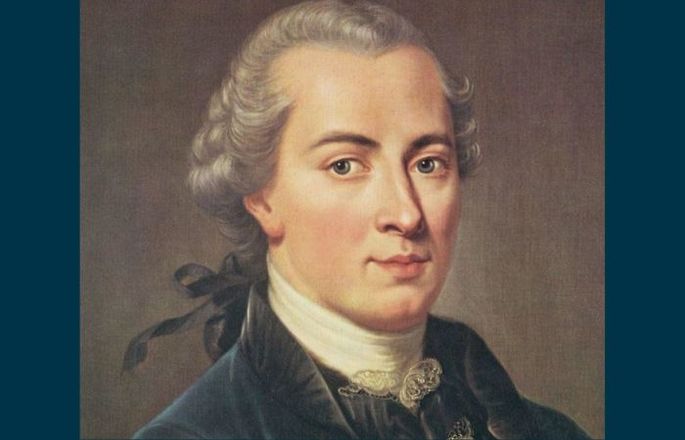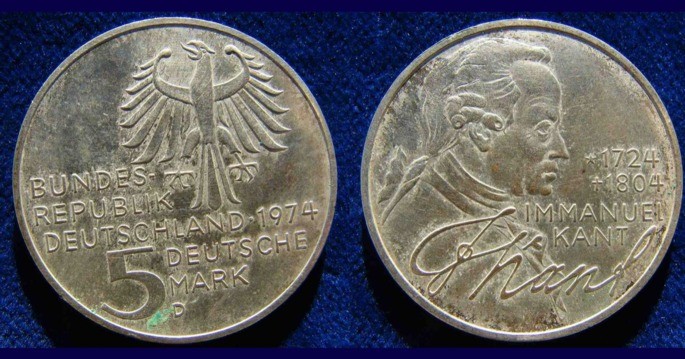Immanuel Kant is one of the most studied philosophers in modern times.
His works are a pillar and starting point for modern German philosophy , with followers such as Fichte, Hegel, Schelling and Schopenhauer.
Kant tried to resolve the issues between the rationalism of Descartes and Leibniz and the empiricism of the philosophers David Hume and John Locke.
Kant’s Life and Work
Immanuel Kant was born in Königsberg, East Prussia, on April 22, 1724.
It was the fourth of nine children of the couple Johann Georg Kant, manufacturer of harnesses for riding, and Anna Regina Kant.
He lived a modest and devoted life to Lutheranism. He studied at “Colégio Fredericianum” before going to “Königsberg University”.
So, after spending his adolescence studying at a Protestant college, he went to the University of Königsberg in 1740.
There, he will be a free lecturer and associate lecturer only in 1755, when he received a doctorate in philosophy, also studying physics and mathematics, in addition to teaching Natural Sciences.
In 1770, he assumed the Chair of Logic and Metaphysics at the University of Königsberg. At this point, the so-called Kantian pre-critical phase ends, in which dogmatic philosophy predominates.
His most emblematic texts of that time were ” The Universal History of Nature ” and ” Theory of Heaven “, from 1775.
In the author’s second phase, the “dogmatic lethargy” is overcome due to the shock suffered by reading the writings of the philosopher David Hume (1711-1776). In this phase, Kant will write ” The Critique of Pure Reason ” (1781) and ” Critique of Practical Reason ” (1788).
In addition, he was a contemporary of American Independence and the French Revolution, having personally seen Napoleon Bonaparte conquer Prussia.
Kant, a methodical and fragile man, was a professor of Physics, Anthropology, Geography, Logic, Metaphysics , etc. In addition, he wrote some essays on history and politics.
He died at the age of 80, in Königsberg, on February 12, 1804.
Curiosities
- Kant did nothing famous until he was 50 years old, when his second phase began, in which he produced frantically.
- Immanuel Kant was methodical, systematic and punctual. At precisely 3:30 pm, he went for a walk, this being an event to regulate the clocks in the city.
Kant’s Main Ideas
Kant reveals that the spirit or reason, shapes and coordinates the sensations, of which the impressions of the external senses are only raw material for knowledge.
Aesthetic and teleological judgment unites our moral and empirical judgments in order to unify your system.
It is worth mentioning that Kant was an enthusiast of European and American Enlightenment , where he published the work ” What is Enlightenment? ” (1784).

In this work, he synthesizes the possibility of man to follow his own reason, which would be, at the same time, man’s exit from his minority.
This is defined as man’s inability to make use of his own understanding.
In other words, the fact of not daring to think, for reasons of cowardice and laziness, the main reasons for human permanence in the minority.
The “Kantian Criticism” and “The Judgments”
In the work ” Critique of pure reason ” (1781), Kant seeks to formulate ways for us to make good use of understanding.
When realizing that we are limited by what we are given to know, we cannot know the truth about the world “as it is in itself”. That’s because we perceive and think the world in determined ways.
Thus, it is essential to study how knowledge can be limited, as this leads to its possibilities and its real applications.

In ” Critique of practical reason ” (1788), Kant formulates the bases of his moral philosophy. What underlies human action and what we are given to do, thus, constitute a treatise on human morality.
In this work, the author unveils morality in a similar way to the way he formulates his approach to knowledge. He discusses the principles of moral action as a way of separating morals from a religious foundation.
For him, reason was sufficiently capable of resolving issues related to morality, without needing the appeal to superstition or supernatural elements. In this, it develops its categorical imperative , a rational formula for the resolution of moral issues.
Therefore, Kant formulates the ” synthetic judgment ” to deal with experimentation as a guarantee of true knowledge. According to him, it is not possible to reach the truth just by analyzing his propositions.
” Analytical judgment “, on the other hand, is based on the principle of identity. In it, the predicate points to an attribute contained in the subject and, when the subject is denied, the predicate is denied (vice versa).
The ” aesthetic judgment “, in turn, would only be possible for those with the power to judge. These would be the only ones capable of a critical investigation into the concept of “beautiful”.
Kant quotes

- ” The supreme mission of man is to know what he needs to be a man .”
- “Two things that fill my soul with growing admiration and respect: the starry sky above me and the moral law within me.”
- “ The wise man can change his mind. The ignorant, never . ”
- ” We are not rich by what we have, but by what we don’t need to have .”
- “ Science is organized knowledge. Wisdom is organized life . ”
- ” Judgment in general is the faculty of thinking the particular as understood under the universal .”
- ” Happiness is the state in the world of a reasonable being, to whom, throughout the course of his existence, everything happens according to his aspiration and his will .”

